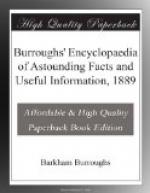ICED TEA A LA RUSSE.—To each glass of tea add the juice of half a lemon, fill up the glass with pounded ice, and sweeten.
GENERAL DIRECTIONS FOR MAKING BREAD.—In the composition of good bread, there are three important requisites: Good flour, good yeast, [and here let us recommend Gillett’s Magic Yeast Cakes. They keep good for one year in any climate, and once used you will not do without it. All grocers keep it] and strength to knead it well. Flour should be white and dry, crumbling easily again after it is pressed in the hand.
A very good method of ascertaining the quality of yeast will be to add a little flour to a very small quantity, setting it in a warm place. If in the course of ten or fifteen minutes it raises, it will do to use.
When you make bread, first set the sponge with warm milk or water, keeping it in a warm place until quite light. Then mold this sponge, by adding flour, into one large loaf, kneading it well. Set this to rise again, and then when sufficiently light mold it into smaller loaves, let it rise again, then bake. Care should be taken not to get the dough too stiff with flour; it should be as soft as it can be to knead well. To make bread or biscuits a nice color, wet the dough over top with water just before putting it into the oven. Flour should always be sifted.
BROWN BREAD, for those who can eat corn-meal: Two cups Indian meal to one cup flour; one-half teacup syrup, 2-1/2 cups milk; 1 teaspoon salt; 3 teaspoons of Gillett’s baking powder. Steam an hour and a half. To be eaten hot. It goes very nicely with a corn-beef dinner.
BROWN BREAD.—Stir together wheat meal and cold water (nothing else, not even salt) to the consistency of a thick batter. Bake in small circular pans, from three to three and a half inches in diameter, (ordinary tin pattypans do very well) in a quick, hot oven. It is quite essential that it be baked in this sized cake, as it is upon this that the raising depends. [In this article there are none of the injurious qualities of either fermented or superfine flour bread; and it is so palpably wholesome food, that it appeals at once to the common sense of all who are interested in the subject.]
BROWN BREAD—Take part of the sponge that has been prepared for your white bread, warm water can be added, mix it with graham flour (not too stiff).
BOSTON BROWN BREAD.—To make one loaf:—Rye meal unsifted, half a pint; Indian meal sifted, one pint; sour milk, one pint; molasses, half a gill. Add a teaspoonful of salt, one teaspoonful of soda dissolved in a little hot water; stir well, put in a greased pan, let it rise one hour, and steam four hours.
BOSTON BROWN BREAD.—One and one-half cups of graham flour, two cups of corn meal, one-half cup of molasses, one pint of sweet milk, and one-half a teaspoon of soda; steam three hours.
CORN BREAD.—One-half pint of buttermilk, one-half pint of sweet milk; sweeten the sour milk with one-half teaspoon of soda; beat two eggs, whites and yolks together; pour the milk into the eggs, then thicken with about nine tablespoons of sifted corn meal. Put the pan on the stove with a piece of lard the size of an egg; when melted pour it in the batter; this lard by stirring it will grease the pan to bake in; add a teaspoon of salt.




